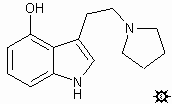
#24. 4-HO-PYR-T
TRYPTAMINE, 4-HYDROXY-N,N-TETRAMETHYLENE; 4-INDOLOL, 3-[2-(1-PYRROLIDYL)ETHYL]; PYRROLIDINE, 1-[2-[3-(4-HYDROXY)INDOLYL]ETHYL]; 4-HYDROXY-N,N-TETRAMETHYLENETRYPTAMINE; 3-[2-(1-PYRROLIDYL)ETHYL]-4-INDOLOL; 1-[2-[3-(4-HYDROXY)INDOLYL]ETHYL]PYRROLIDINE; "4-HYDROXYPYRROLIDYLINDOLE"

|
| [3D .mol structure] |
To a stirred suspension of 0.25 g LAH in 10 mL anhydrous THF, under nitrogen and at room temperature, there was added a solution of 0.30 g 4-acetoxyindol-3-yl-N,N-tetramethyleneglyoxylamide in 10 mL anhydrous THF. This was added dropwise at a rate that maintained the reaction at reflux. When the addition was complete, the reflux was maintained for an additional 15 min and then the reaction was cooled to 40 °C. The excess hydride and the product complex were destroyed by the addition of 0.5 mL EtOAC followed by 1.5 mL H2O. The solids were removed by filtration, the filter cake washed with THF, the filtrate and washings pooled, and the solvents removed under vacuum. The residue was recrystallized from EtOAC/hexane to give 0.12 g (50%) of 4-Hydroxy-N,N-tetramethylenetryptamine (4-HO-pyr-T) with a mp 193-195 °C. Anal: C,H,N.
DOSAGE : >20 mg
DURATION : unknown
QUALITATIVE COMMENTS : (with 20 mg, orally) "This substance proved to be quite unlike psilocin and bordered on the bizarre. There was a latency period of about three hours after ingestion before the onset was noted. Visual disturbances were minimal; no alteration in colors or objects occurred. The nature of this compound was characterized by the heightening of the intellectual process, but not to the extent seen with psilocin. The entire experience was more 'stimulant-like' rather than hallucinogenic. A very unpleasant ride. Have no desire to go deeper or, indeed, to look at the other cyclic analogs."
EXTENSIONS AND COMMENTARY : There are three pyrrolidine amines in this tryptamine compilation, and all three are simply weird and illogical. Both the simple "pyrrolidyl tryptamine" (pyr-T) and the 5-methoxy counterpart (5-MeO-pyr-T) caused physical distress, and this one (4-HO-pyr-T) seems to be a more of a stimulant rather than a psychedelic. In all three cases (and with the 5,6-methylenedioxy example as well) the other two ring systems that often accompany the pyrrolide example as a "set" were simply not explored. This is due, largely, to the unexpected and generally negative responses to the pyrrolidine archetype. The piperidine homologue (4-HO-pip-T) is a white crystalline solid with a mp of 180-181 °C. The morpholine analogue is also a white crystalline solid with a mp of 177-178 °C.
| [ |
[Main Index] | [Forward |

